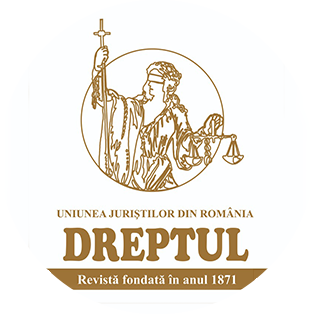-
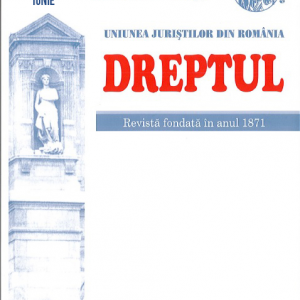 In this article, the authors examine the modality of conducting the procedure of replacement of the measure of preventive detention with the preventive measure of judicial control on bail, respectively if, according to the regulations of the Criminal Procedure Code, at the same time with the admission in principle the judge examines inclusively the grounds of such application or, on the contrary, it requires an initial examination strictly in terms of fulfilment of the formal conditions, finalised with the admission in principle and with fixing the quantum of the bail, and only in the second stage the examination of the application on its merits in terms of its rightfulness. Likewise, there are analyzed the legal remedies against the interlocutory judgment of admission in principle, respectively of the interlocutory judgment whereby the judge rules on the merits of the case. Finally, the authors present the contradictory solutions at the level of different courts of appeal and of the High Court of Cassation and Justice, analyzing inclusively the report drawn up by the supreme court, the Panel for the settlement of some points of law in criminal matters. Likewise, they formulate a series of de lege ferenda proposals, which aim to eliminate the contradictions between the different articles of the Criminal Procedure Code in this matter.
In this article, the authors examine the modality of conducting the procedure of replacement of the measure of preventive detention with the preventive measure of judicial control on bail, respectively if, according to the regulations of the Criminal Procedure Code, at the same time with the admission in principle the judge examines inclusively the grounds of such application or, on the contrary, it requires an initial examination strictly in terms of fulfilment of the formal conditions, finalised with the admission in principle and with fixing the quantum of the bail, and only in the second stage the examination of the application on its merits in terms of its rightfulness. Likewise, there are analyzed the legal remedies against the interlocutory judgment of admission in principle, respectively of the interlocutory judgment whereby the judge rules on the merits of the case. Finally, the authors present the contradictory solutions at the level of different courts of appeal and of the High Court of Cassation and Justice, analyzing inclusively the report drawn up by the supreme court, the Panel for the settlement of some points of law in criminal matters. Likewise, they formulate a series of de lege ferenda proposals, which aim to eliminate the contradictions between the different articles of the Criminal Procedure Code in this matter. -
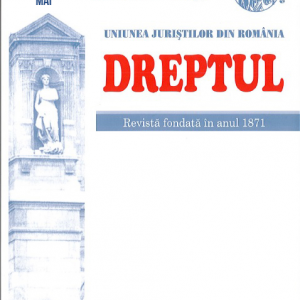 The article deals with the problems of suspension of judgment by the Romanian court based on Article 413 (1) point 1 of the Civil Procedure Code, on the grounds of the existence of a judgment pending before a foreign court.
The article deals with the problems of suspension of judgment by the Romanian court based on Article 413 (1) point 1 of the Civil Procedure Code, on the grounds of the existence of a judgment pending before a foreign court. -
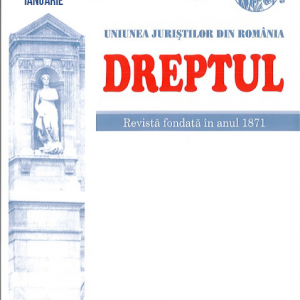 In this article the author raises for discussion some theoretical and practical issues referring to the judicial control and to the judicial control on bail, preventive measures which have been regulated in this form in the new Criminal Procedure Code, focusing on how they are implemented, in order to avoid some errors or confusions related to their interpretation and application.
In this article the author raises for discussion some theoretical and practical issues referring to the judicial control and to the judicial control on bail, preventive measures which have been regulated in this form in the new Criminal Procedure Code, focusing on how they are implemented, in order to avoid some errors or confusions related to their interpretation and application. -
 In this study, the author explains the concepts of: structure of the registered capital; general pledge of the creditors; registered capital; difference between the registered capital and the patrimony of the company; difference between the registered capital and the equity capital (net assets); difference between the registered capital and the value of the company, as well as the problems of the legal regime of social contributions after payments, as all of the above follow from the Law No 31/1990 (republished) on companies.
In this study, the author explains the concepts of: structure of the registered capital; general pledge of the creditors; registered capital; difference between the registered capital and the patrimony of the company; difference between the registered capital and the equity capital (net assets); difference between the registered capital and the value of the company, as well as the problems of the legal regime of social contributions after payments, as all of the above follow from the Law No 31/1990 (republished) on companies. -
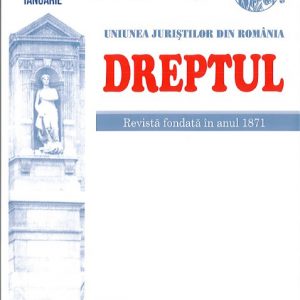 In this study, by analyzing the legal issues of the respect due to persons also after their death, the author, after proceeding to a comparative law examination in the matter, further makes a study of the Romanian legislation in the field under debate (mainly, Articles 78–81 of the new Romanian Civil Code, as well as other legal provisions written down in special laws, such as: the Law No 95/2006 on the reform in the field of healthcare, the Law No 104/2003 on handling of human dead bodies and removal of organs and tissues from the dead bodies in view of transplant and others).
In this study, by analyzing the legal issues of the respect due to persons also after their death, the author, after proceeding to a comparative law examination in the matter, further makes a study of the Romanian legislation in the field under debate (mainly, Articles 78–81 of the new Romanian Civil Code, as well as other legal provisions written down in special laws, such as: the Law No 95/2006 on the reform in the field of healthcare, the Law No 104/2003 on handling of human dead bodies and removal of organs and tissues from the dead bodies in view of transplant and others). -
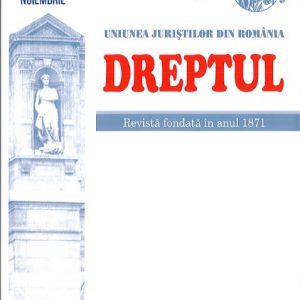 Engaging the civil tort liability has as finality the full reparation of the damage. Reparation is a legal means by which the victim may claim to be reinstated in the situation prior to the commission of the illegal act. The right to reparation depends on an objective fact, that of causing the damage. The condition of the certainty of the damage is its most important character. If the damage is not certain, it can not be ascertained whether the right to reparation arose, and if the uncertainty concerns the extent thereof, the object of the claim for damages can not be established. Sometimes, in practice, it is difficult to determine whether the damage invoked is certain or possible. In relation to this condition of certainty of the damage, the damage by loss of the opportunity to gain an advantage is one of the innovative elements of the new regulation, being outlined as a distinct category of reparable damage.
Engaging the civil tort liability has as finality the full reparation of the damage. Reparation is a legal means by which the victim may claim to be reinstated in the situation prior to the commission of the illegal act. The right to reparation depends on an objective fact, that of causing the damage. The condition of the certainty of the damage is its most important character. If the damage is not certain, it can not be ascertained whether the right to reparation arose, and if the uncertainty concerns the extent thereof, the object of the claim for damages can not be established. Sometimes, in practice, it is difficult to determine whether the damage invoked is certain or possible. In relation to this condition of certainty of the damage, the damage by loss of the opportunity to gain an advantage is one of the innovative elements of the new regulation, being outlined as a distinct category of reparable damage. -
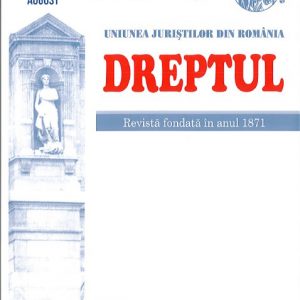 In this study, the author makes an analysis on the right to life, with emphasis on the moment when the right to life begins to flow, including from the phase of conception of human life, by reference to the case law of the European Court of Human Rights and of other courts outside the European Union, following that, in the final part of the study, an analysis be made on the current criminal provisions protecting the right to life in its incipient phase and the compliance of these provisions with the standard required by the Convention.
In this study, the author makes an analysis on the right to life, with emphasis on the moment when the right to life begins to flow, including from the phase of conception of human life, by reference to the case law of the European Court of Human Rights and of other courts outside the European Union, following that, in the final part of the study, an analysis be made on the current criminal provisions protecting the right to life in its incipient phase and the compliance of these provisions with the standard required by the Convention. -
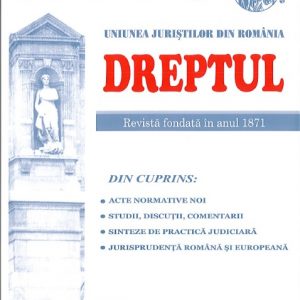 This study appeared as a result of a case solved in practice and identifies legal issues also common to many other cases, which, as always, is subject to the analysis and to the specialised criticism, the latter being accompanied by any other possible points of view.
This study appeared as a result of a case solved in practice and identifies legal issues also common to many other cases, which, as always, is subject to the analysis and to the specialised criticism, the latter being accompanied by any other possible points of view. -
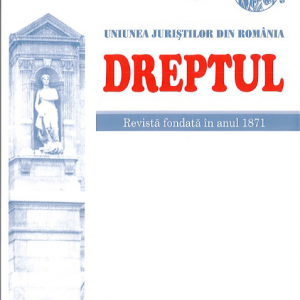 Throughout more than 150 years of constitutional history in Romania, the Romanian constitutions have provided the modality of engaging the liability of the ministers for their activity. This article aims to make a brief analysis of how it was regulated the liability of ministers in the various constitutions which Romania has adopted over time and of the relation between the political and legal liability of ministers in the Romanian law, starting from the practical realities of recent years. Although, traditionally, in the constitutional law it is made a clear distinction between the political and legal liability, in practice, the boundary between the two types of liability is questionable, especially from the perspective of the legal classification of these types of liability. If the political liability is considered to be that liability of ministers before the Parliament for their political activity which may result in the loss of confidence and the removal from the office of minister, the legal liability has in view how a minister should bear the consequences of the law, by his prosecution and indictment.
Throughout more than 150 years of constitutional history in Romania, the Romanian constitutions have provided the modality of engaging the liability of the ministers for their activity. This article aims to make a brief analysis of how it was regulated the liability of ministers in the various constitutions which Romania has adopted over time and of the relation between the political and legal liability of ministers in the Romanian law, starting from the practical realities of recent years. Although, traditionally, in the constitutional law it is made a clear distinction between the political and legal liability, in practice, the boundary between the two types of liability is questionable, especially from the perspective of the legal classification of these types of liability. If the political liability is considered to be that liability of ministers before the Parliament for their political activity which may result in the loss of confidence and the removal from the office of minister, the legal liability has in view how a minister should bear the consequences of the law, by his prosecution and indictment. -
 This article presents the procedural features of the principle non reformatio in pejus in civil procedural area. It aims to concentrate the main theoretical and practical concepts exposed during the time, relating to the limits of this principle. Finally, the study is dedicated to analyze the real interference between different peremptory rules, which govern the appeal, and the principle analyzed.
This article presents the procedural features of the principle non reformatio in pejus in civil procedural area. It aims to concentrate the main theoretical and practical concepts exposed during the time, relating to the limits of this principle. Finally, the study is dedicated to analyze the real interference between different peremptory rules, which govern the appeal, and the principle analyzed. -
 Accepting co-authorship in the commission of acts with basic intent has represented, sine die, a permanent struggle for scholars since the adoption of the 1968 Criminal Code. Both the literature and the judiciary have had divergent positions. In the present paper, the purpose is to assess all factors that can lead to a positive or negative answer to the question: Is co-authorship compatible with basic-intent? The analysis will be divided: the national status-quo versus the alternative solution, respectively the German one. In the national arena, the existing arguments and the foundations for the possible envisioned outcomes will be discussed. Within the German framework, the institution of Nebentäterschaft will be assessed in a comparative approach, underlying similarities and differences when compared to the Romanian framework. Finally, a personal note will be added to the mix.
Accepting co-authorship in the commission of acts with basic intent has represented, sine die, a permanent struggle for scholars since the adoption of the 1968 Criminal Code. Both the literature and the judiciary have had divergent positions. In the present paper, the purpose is to assess all factors that can lead to a positive or negative answer to the question: Is co-authorship compatible with basic-intent? The analysis will be divided: the national status-quo versus the alternative solution, respectively the German one. In the national arena, the existing arguments and the foundations for the possible envisioned outcomes will be discussed. Within the German framework, the institution of Nebentäterschaft will be assessed in a comparative approach, underlying similarities and differences when compared to the Romanian framework. Finally, a personal note will be added to the mix. -
 The application of ancillary intervention submitted in favour of the authority that has issued the individual administrative act is admissible in the actions in administrative disputes having as object the suspension of this type of acts, to the extent to which the third party intervening in a trial between the original parties is able to prove the practical benefit which he obtains as a consequence of pronouncing a solution favourable to the party in whose favour it intervenes. The necessity to prove that the condition of imminent damage is fulfilled by the applicant who considers himself injured, by the individual administrative act whose suspension is requested, does not confer this action a personal nature, in such a way as to be incompatible with the institution of ancillary intervention.
The application of ancillary intervention submitted in favour of the authority that has issued the individual administrative act is admissible in the actions in administrative disputes having as object the suspension of this type of acts, to the extent to which the third party intervening in a trial between the original parties is able to prove the practical benefit which he obtains as a consequence of pronouncing a solution favourable to the party in whose favour it intervenes. The necessity to prove that the condition of imminent damage is fulfilled by the applicant who considers himself injured, by the individual administrative act whose suspension is requested, does not confer this action a personal nature, in such a way as to be incompatible with the institution of ancillary intervention. -
 The modality of enforcement through garnishment involves the existence of a legal relationship, in which the pursued debtor has the quality of creditor, and the garnishee has the quality of debtor, a legal relationship used by the pursuing creditor in order to realize the claim from the writ of execution. The garnishment knows two phases, the one of establishment and the one of validation, the second one intervening only if the garnishee fails to fulfil its obligations as a result of communicating the address for establishment of garnishment. The application for validation of the garnishment is a veritable application for summons, its finality being to obtain a writ of execution by the executing creditor against the garnishee. The study examines the defences which the garnishee can invoke in the court of validation, having regard to the legislative solution provided by the current Civil Procedure Code, according to which a garnishee is forbidden to file a contestation to the enforcement against the acts establishing the garnishment, the latter being able to use his defences only before the court of validation [Article 787 (5) of the Civil Procedure Code]. Therefore, the processual means of invoking the defences before the court of validation are analyzed, being questioned the admissibility of the garnishee’s filing of a counter claim aiming at the cancellation of the juridical act from which the relationship between him and the debtor arose. The defences of the garnishee are analyzed starting with the distinction between defences on the merits and the processual and procedural ones, in relation to the possibility conferred to the third party to invoke against the creditor all the pleas and defences that he may oppose to the debtor, to the extent that they are prior to the establishment of garnishment [Article 790 (3) of the Civil Procedure Code].
The modality of enforcement through garnishment involves the existence of a legal relationship, in which the pursued debtor has the quality of creditor, and the garnishee has the quality of debtor, a legal relationship used by the pursuing creditor in order to realize the claim from the writ of execution. The garnishment knows two phases, the one of establishment and the one of validation, the second one intervening only if the garnishee fails to fulfil its obligations as a result of communicating the address for establishment of garnishment. The application for validation of the garnishment is a veritable application for summons, its finality being to obtain a writ of execution by the executing creditor against the garnishee. The study examines the defences which the garnishee can invoke in the court of validation, having regard to the legislative solution provided by the current Civil Procedure Code, according to which a garnishee is forbidden to file a contestation to the enforcement against the acts establishing the garnishment, the latter being able to use his defences only before the court of validation [Article 787 (5) of the Civil Procedure Code]. Therefore, the processual means of invoking the defences before the court of validation are analyzed, being questioned the admissibility of the garnishee’s filing of a counter claim aiming at the cancellation of the juridical act from which the relationship between him and the debtor arose. The defences of the garnishee are analyzed starting with the distinction between defences on the merits and the processual and procedural ones, in relation to the possibility conferred to the third party to invoke against the creditor all the pleas and defences that he may oppose to the debtor, to the extent that they are prior to the establishment of garnishment [Article 790 (3) of the Civil Procedure Code]. -
 The institution of the penal clause, regulated in Articles 1538–1543 of the new Civil Code, still encounters different interpretations, even contradictory sometimes, in the judicial practice and in the solutions of the courts. In particular, the interest of the practitioners and of the specialized doctrine is based on the possibility conferred to the court of law to reduce the penal clause in the two cases provided by the legislator, namely when the main obligation has been executed by the debtor to the benefit of the creditor and when the penalty is clearly excessive in relation to the prejudice which might have been foreseen by the parties on the conclusion of the contract. This study aims to analyse thoroughly the two hypostases in which the judge is allowed to defeat the principle of binding force of the contract and to intervene in the decrease of the quantum of penalties, an analysis materialized both from a theoretical point of view and especially from a practical point of view, offering relevant solutions from the recent judicial practice.
The institution of the penal clause, regulated in Articles 1538–1543 of the new Civil Code, still encounters different interpretations, even contradictory sometimes, in the judicial practice and in the solutions of the courts. In particular, the interest of the practitioners and of the specialized doctrine is based on the possibility conferred to the court of law to reduce the penal clause in the two cases provided by the legislator, namely when the main obligation has been executed by the debtor to the benefit of the creditor and when the penalty is clearly excessive in relation to the prejudice which might have been foreseen by the parties on the conclusion of the contract. This study aims to analyse thoroughly the two hypostases in which the judge is allowed to defeat the principle of binding force of the contract and to intervene in the decrease of the quantum of penalties, an analysis materialized both from a theoretical point of view and especially from a practical point of view, offering relevant solutions from the recent judicial practice. -
 Presumptions have been playing an important role in the civil trial, their necessity and utility being recognized both in the doctrine and in the judicial practice. Recently, in order to remove any doubt about the quality of means of evidence of the presumptions, the legislator of the Civil Procedure Code enumerates them among the means of evidence and, at the same time, establishes their legal regime, and the legislator of the Civil Code has extended the scope of the legal presumptions. The reason behind these regulations is based precisely on the necessity to find out the truth also in the cases in which the judge does not have available direct evidence. Certainly, as we have stated on another occasion, the presumptions are indirect means of evidence, as the conclusions drawn imply eo ipso the prior proof of a fact that is neighbouring and related to the unknown fact. As we shall further show, the Romanian legislator has understood to classify the presumptions into legal (established by law) and judicial or simple (left to the enlightments and wisdom of the judge), with the mention that, in this study, we shall refer in particular to the legal presumptions.
Presumptions have been playing an important role in the civil trial, their necessity and utility being recognized both in the doctrine and in the judicial practice. Recently, in order to remove any doubt about the quality of means of evidence of the presumptions, the legislator of the Civil Procedure Code enumerates them among the means of evidence and, at the same time, establishes their legal regime, and the legislator of the Civil Code has extended the scope of the legal presumptions. The reason behind these regulations is based precisely on the necessity to find out the truth also in the cases in which the judge does not have available direct evidence. Certainly, as we have stated on another occasion, the presumptions are indirect means of evidence, as the conclusions drawn imply eo ipso the prior proof of a fact that is neighbouring and related to the unknown fact. As we shall further show, the Romanian legislator has understood to classify the presumptions into legal (established by law) and judicial or simple (left to the enlightments and wisdom of the judge), with the mention that, in this study, we shall refer in particular to the legal presumptions. -
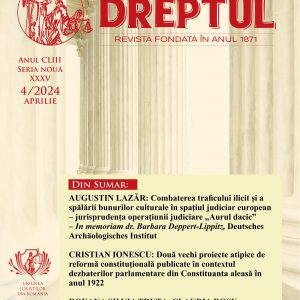
-
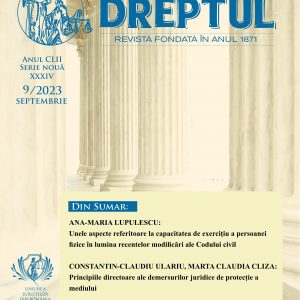
-
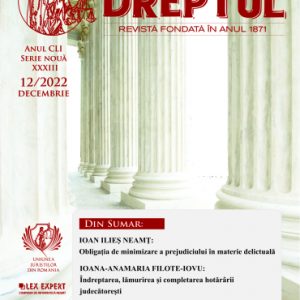 Pre-trial detention was defined as the most intrusive custodial preventive measure in the exercise of the person’s right to freedom, by which the judge or the court orders the detention of the defendant for the duration and under the specific conditions provided by law, in places specially intended for this purpose, in the interest of the criminal prosecution, the preliminary chamber procedure or the trial. In order to take pre-trial detention, it is necessary to meet all the general conditions provided by law for taking preventive measures, as well as the existence of at least one of the prev. of Article 223 of the Civil Procedure Code. In practice, in almost all cases, preventive arrest is based on the provisions of Article 223 (2) of the Civil Procedure Code. Under these conditions, we tried to create both a general presentation of these grounds and a theoretical analysis of the main issues that can generate confusion and problems in the application of the cases provided for by Article 223 (1) of the Civil Procedure Code. All this theoretical analysis has, as far as possible, been examined in conjunction with solutions from judicial practice, where appropriate.
Pre-trial detention was defined as the most intrusive custodial preventive measure in the exercise of the person’s right to freedom, by which the judge or the court orders the detention of the defendant for the duration and under the specific conditions provided by law, in places specially intended for this purpose, in the interest of the criminal prosecution, the preliminary chamber procedure or the trial. In order to take pre-trial detention, it is necessary to meet all the general conditions provided by law for taking preventive measures, as well as the existence of at least one of the prev. of Article 223 of the Civil Procedure Code. In practice, in almost all cases, preventive arrest is based on the provisions of Article 223 (2) of the Civil Procedure Code. Under these conditions, we tried to create both a general presentation of these grounds and a theoretical analysis of the main issues that can generate confusion and problems in the application of the cases provided for by Article 223 (1) of the Civil Procedure Code. All this theoretical analysis has, as far as possible, been examined in conjunction with solutions from judicial practice, where appropriate. -
 In this study, the author, emphasizing the difficulties encountered by judicial practice in the use, interpretation and application of law enforcement, clarification and completion of judgments, wishes to clarify these procedures, proposing some legislative changes to ensure clarity of incident rules. Thus, situations are presented in which, by means of a request for correction, misjudgments have been corrected, or both requests for clarification of the decision and a title appeal have been formulated, as well as doctrinal controversies regarding the right of option of the party between the procedure for completing the decision and the appeal for review.
In this study, the author, emphasizing the difficulties encountered by judicial practice in the use, interpretation and application of law enforcement, clarification and completion of judgments, wishes to clarify these procedures, proposing some legislative changes to ensure clarity of incident rules. Thus, situations are presented in which, by means of a request for correction, misjudgments have been corrected, or both requests for clarification of the decision and a title appeal have been formulated, as well as doctrinal controversies regarding the right of option of the party between the procedure for completing the decision and the appeal for review. -
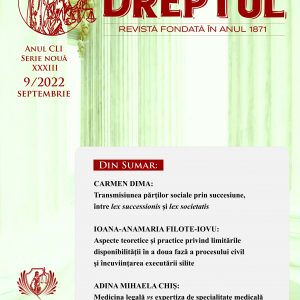 In practical situations with medical implications, the nature of the expertise must be established as a matter of priority. This matter involves a series of discussions on the differences between forensic expertise and specialized medical expertise. Nowadays, forensic expertise continues to be approached from an obsolete perspective, without detecting its limits in medical or legal matters. Highlighting the differences between the two categories of expertise and the shortcomings of the relevant legislation has major practical consequences. The utility of this study lies in terms of analyzing the legal significance of respecting the medical specialty and the object of the medical expertise – a new category of expertise, which seems to be of no practical use, despite its great importance. This respects the principle of medical specialty and takes into account also the level of development of medical science in the field of expertise. Adherence to incidental medical guidelines or protocols can be verified only by a specialized medical expertise, the only one able to analyze the compliance of the medical conduct. Instead, the limits of forensic expertise are revealed by its object, which is just another expertise in medical law, without encompassing the entire medical or legal matter, in a single specialty. The two types of work must be clearly delimited in judicial practice, for the full clarification of legal situations with medical implications, regardless of their nature.
In practical situations with medical implications, the nature of the expertise must be established as a matter of priority. This matter involves a series of discussions on the differences between forensic expertise and specialized medical expertise. Nowadays, forensic expertise continues to be approached from an obsolete perspective, without detecting its limits in medical or legal matters. Highlighting the differences between the two categories of expertise and the shortcomings of the relevant legislation has major practical consequences. The utility of this study lies in terms of analyzing the legal significance of respecting the medical specialty and the object of the medical expertise – a new category of expertise, which seems to be of no practical use, despite its great importance. This respects the principle of medical specialty and takes into account also the level of development of medical science in the field of expertise. Adherence to incidental medical guidelines or protocols can be verified only by a specialized medical expertise, the only one able to analyze the compliance of the medical conduct. Instead, the limits of forensic expertise are revealed by its object, which is just another expertise in medical law, without encompassing the entire medical or legal matter, in a single specialty. The two types of work must be clearly delimited in judicial practice, for the full clarification of legal situations with medical implications, regardless of their nature. -
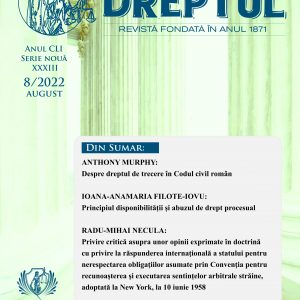 Globalization, the changing concepts of the family definition and the emergence of new medical techniques for conceiving children have led to the emergence of substitution maternity and the issue of inheritance rights for children born of such a procedure. At international level, no comparable moral or legal basis can be identified in this area. The creation of a common legal framework or the advancement of a large-scale international unification of substantive law or rules on the recognition of the effects of foreign laws seems to be a distant goal to achieve. The issue of the inheritance rights of children born of surrogacy motherhood is a very complex one and currently without legislative protection. On European Union level, European Regulation 650/2012 has been in force since 2012, but there are no provisions on the situation of inheritance rights deriving from a surrogacy contract. The study aims to analyse the general concepts recognised in international, European and national law with regard to the creation of a legal framework as structured as possible for the protection of the inheritance rights of children born of substitution maternity, and to understand how this medical practice works. Another objective will be to analyse the decisions of the European Court of Human Rights, the decisions of the Court of Justice of the European Union and the national courts decisions, in order to find solutions on how to protect inheritance rights in such a situation.
Globalization, the changing concepts of the family definition and the emergence of new medical techniques for conceiving children have led to the emergence of substitution maternity and the issue of inheritance rights for children born of such a procedure. At international level, no comparable moral or legal basis can be identified in this area. The creation of a common legal framework or the advancement of a large-scale international unification of substantive law or rules on the recognition of the effects of foreign laws seems to be a distant goal to achieve. The issue of the inheritance rights of children born of surrogacy motherhood is a very complex one and currently without legislative protection. On European Union level, European Regulation 650/2012 has been in force since 2012, but there are no provisions on the situation of inheritance rights deriving from a surrogacy contract. The study aims to analyse the general concepts recognised in international, European and national law with regard to the creation of a legal framework as structured as possible for the protection of the inheritance rights of children born of substitution maternity, and to understand how this medical practice works. Another objective will be to analyse the decisions of the European Court of Human Rights, the decisions of the Court of Justice of the European Union and the national courts decisions, in order to find solutions on how to protect inheritance rights in such a situation. -
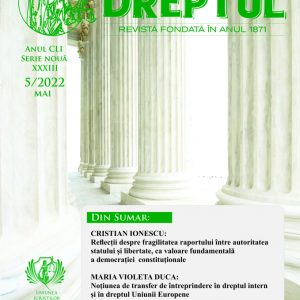 The premise of this study is that the current legislation uses two legal notions with relatively different names, that is the „legitimate interest” in the administrative contentious procedure, regulated by the Law No 554/2004, and the „interest to act”, used in the Civil Procedure Code, both representing conditions of admissibility of the judicial action (in administrative contentious and, respectively, civil action). The aim pursued by the author was to observe whether these legal notions are synonyms or they differ, in terms of their processual connotation, depending on the nature of the legal action promoted. In this regard, the author has compared the two legal notions, revealing the similarities and differences between them, and, at the end of the study, he has set out the theoretical and practical arguments for the purpose of recognizing their processual autonomy.
The premise of this study is that the current legislation uses two legal notions with relatively different names, that is the „legitimate interest” in the administrative contentious procedure, regulated by the Law No 554/2004, and the „interest to act”, used in the Civil Procedure Code, both representing conditions of admissibility of the judicial action (in administrative contentious and, respectively, civil action). The aim pursued by the author was to observe whether these legal notions are synonyms or they differ, in terms of their processual connotation, depending on the nature of the legal action promoted. In this regard, the author has compared the two legal notions, revealing the similarities and differences between them, and, at the end of the study, he has set out the theoretical and practical arguments for the purpose of recognizing their processual autonomy. -
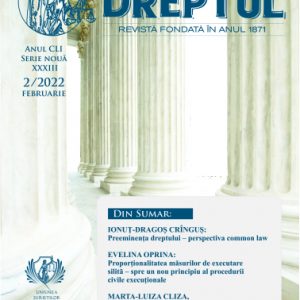 Proportionality of the enforcement measures constitutes, in essence, a fundamental principle of the civil enforcement procedure, which, although it does not have a regulation in terminis recognized in the Civil Procedure Code, already knows, at regulatory level, the valences of a principle, following only to be assimilated by the doctrine, by the practice and, consequently, by the legislator. Although it could be argued that proportionality is subsumed to the general principle of the right to a fair trial, we consider that it claims its own individuality at the level of the fundamental thesis leading the enforcement process, as compared to the specificity of the measures involved, the fairness of the procedure following to be appreciated by reference to the level at which all the other principles are observed, being a corollary thereof. The procedural guarantees which they enjoy, the remedies and the legally recognized consequences are elements that turn, therefore, the proportionality of the enforcement measures into a basic principle of the enforcement, on which a fair procedure is built, thus giving full expression to the valorisation of the rights and fundamental freedoms of the individual.
Proportionality of the enforcement measures constitutes, in essence, a fundamental principle of the civil enforcement procedure, which, although it does not have a regulation in terminis recognized in the Civil Procedure Code, already knows, at regulatory level, the valences of a principle, following only to be assimilated by the doctrine, by the practice and, consequently, by the legislator. Although it could be argued that proportionality is subsumed to the general principle of the right to a fair trial, we consider that it claims its own individuality at the level of the fundamental thesis leading the enforcement process, as compared to the specificity of the measures involved, the fairness of the procedure following to be appreciated by reference to the level at which all the other principles are observed, being a corollary thereof. The procedural guarantees which they enjoy, the remedies and the legally recognized consequences are elements that turn, therefore, the proportionality of the enforcement measures into a basic principle of the enforcement, on which a fair procedure is built, thus giving full expression to the valorisation of the rights and fundamental freedoms of the individual. -
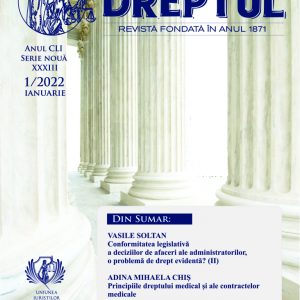 The article addresses the newly introduced legal institution of verification of the legality and lawfulness of protective measures during the criminal trial, which institutes the obligation of the criminal judicial body to periodically analyze whether the legal and factual grounds on which it was previously taken or maintained continue to exist, following to be ordered its maintenance, cancellation, extension or limitation. Through the novelty of the subject under analysis, the study will contribute to the outlining of the guidelines of judicial practice in this unique legal matter.
The article addresses the newly introduced legal institution of verification of the legality and lawfulness of protective measures during the criminal trial, which institutes the obligation of the criminal judicial body to periodically analyze whether the legal and factual grounds on which it was previously taken or maintained continue to exist, following to be ordered its maintenance, cancellation, extension or limitation. Through the novelty of the subject under analysis, the study will contribute to the outlining of the guidelines of judicial practice in this unique legal matter.
